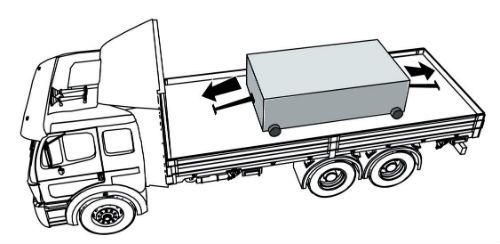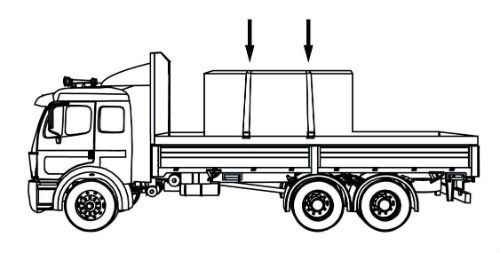CDL Practice Tests: Flatbed Cargo Securement
Choose A Section:
Go!A device placed between the deck of a vehicle and car or between articles of cargo, intended to provide greater friction than exists naturally between these surfaces is:
- A chock.
- Void filler.
- A friction mat.
- A cleat.
Friction mat:
A device placed between the deck of a vehicle and car or between articles of cargo, intended to provide greater friction than exists naturally between these surfaces.
The load carrying area of a truck, trailer, or intermodal container is referred to as the:
- Bulkhead
- Deck
- Headboard
- Well
Deck:
The load carrying area of a truck, trailer, or intermodal container.
What is a cab shield?
- A structure, device, or another substantial article placed against or around an article to prevent horizontal movement of the article.
- A vertical barrier across the front of the deck of a vehicle to prevent forward movement of cargo.
- The depression formed between two cylindrical articles when they are laid with their eyes horizontal and parallel against each other.
- A vertical barrier placed directly behind the cab of a tractor to protect the cab in the event cargo should shift forward.
A hook-lift container is:
- A reusable, transportable enclosure that is especially designed with integral locking devices that secure it to a container chassis trailer to facilitate the efficient and bulk shipping and transfer of goods by, or between various modes of transport, such as highway, rail, sea, and air.
- A vehicle especially built and fitted with locking devices for the transport of intermodal containers.
- The load carrying area of a truck, trailer, or intermodal container.
- A specialized container, primarily used to contain and transport materials in the waste, recycling, construction/demolition, and scrap industries, which are used in conjunction with specialized vehicles, in which the container isloaded and unloaded onto a tilt frame body by an articulating hook-arm.
Hook-lift Container:
A specialized container, primarily used to contain and transport materials in the waste, recycling, construction/demolition, and scrap industries, which are used in conjunction with specialized vehicles, in which the container isloaded and unloaded onto a tilt frame body by an articulating hook-arm.
The North American Cargo Securement Standard cover vehicles weighing:
- 26,001 lbs
- Over 10,000 lbs
- Over 4,500 lbs
- Less than 10,000 lbs
North American Cargo Securement Standard
What does the Standard cover? (Section 1.1)
- Commercial vehicles (including a combination of vehicles) that are operated on a highway and have a gross vehicle rating over 4,500 kg (10,000 lb.)
Vehicles
Define 'bolster':
- An inflatable bag intended to fill otherwise empty space between articles of cargo, or between articles of cargo and the wall of the vehicle.
- A structure, device, or another substantial article placed against or around an article to prevent horizontal movement of the article.
- A vertical barrier across the front of the deck of a vehicle to prevent forward movement of cargo.
- A crosswise load bearing structural component, particularly a part of a log bunk.
Bolster:
A crosswise load bearing structural component, particularly a part of a log bunk.
When securing a load of lengthwise longwood logs weighing 42,500 lbs, what is the minimum aggregate WLL required for tiedowns? (rounded up to nearest lb)
- 10,000 lbs
- 21,250 lbs
- 8,550 lbs
- 7,085 lbs.
Working load limit for longwood and shortwood loaded lengthwise
The aggregate working load limit for all tiedowns must be no less than 1/6 the weight of the stack of logs.
Note: This requirement is much less than the general requirement of an aggregate working load limit equal to 1/2 the weight of the load. This lowered requirement recognizes that the bunks/stakes help to prevent slippage.
What is the minimum WLL of each tiedown used to secure crushed or flattened vehicles?
- 5,000 lbs
- 2,268 lbs
- It depends on the vehicle
- 10,000 lbs
Option 2:
Has containment walls on three sides that:
- Extend to the full height of the load
- Block against cargo movement in the forward, rearward, and one sideways direction.
Secures each stack of vehicles with a minimum of two tiedowns, each having a minimum WLL of 2,268 kg (5,000 lb.).
Option 3:
Has containment walls on two sides that:
- Extend to the full height of the load.
- Block against cargo movement in the forward and rearward.
Secures each stack of vehicles with a minimum of three tiedowns, each having a minimum WLL of 2,268 kg (5,000 lb.).
Option 4:
Has a minimum of four tiedowns per vehicle stack with each tiedown having a minimum WLL of 2,268 kg (5,000 lb.).
A bulkhead is defined as:
- A vertical barrier placed directly behind the cab of a tractor to protect the cab in the event cargo should shift forward.
- A vertical barrier across a vehicle to prevent forward movement of cargo.
- A structure, device, or another substantial article placed against or around an article to prevent horizontal movement of the article.
- A vertical barrier across the front of the deck of a vehicle to prevent forward movement of cargo.
Bulkhead:
A vertical barrier across a vehicle to prevent forward movement of cargo.
What is a headboard?
- A vertical barrier placed directly behind the cab of a tractor to protect the cab in the event cargo should shift forward.
- A vertical barrier across a vehicle to prevent forward movement of cargo.
- A vertical barrier across the front of the deck of a vehicle to prevent forward movement of cargo.
- A transverse load bearing structural component, particularly a part of a log bunk.
Headboard:
A vertical barrier across the front of the deck of a vehicle to prevent forward movement of cargo.
About The Flatbed Cargo Securement CDL Manual
Studying the flatbed cargo securement CDL manual is not a requirement for getting your CDL permit or license. It is required knowledge for flatbed drivers.
Some questions you should be able to answer for flatbed cargo securement:
- What is the minimum Working Load Limit of a tiedown used to secure logs?
- What is the minimum weight of a shipment of paper rolls that would require specific securement requirements?
- When securing concrete pipe over 45 inches loaded crosswise, which direction must the tiedowns on the front half of the load run?
- What is a cab shield?
- When securing concrete pipe over 45 inches loaded crosswise, which direction must the tiedowns on the rear half of the load run?
- What is a dunnage bag?
- Who is responsible for inspecting securing devices and cargo within the first 50 miles?
- How many tiedowns are required on a stack of shortwood loaded crosswise?
- What is the minimum working load limit of each tiedown used to secure crushed or flattened vehicles?
- Define 'bolster'
- What is a hook-lift container?
- When a tiedown is attached directly to the cargo, what is the ideal angle where it attached to the vehicle?
What is a securing device?
Any device specifically manufactured to attach or secure cargo to a vehicle or trailer:
- Synthetic Webbing
- Chain
- Wire rope
- Manila rope
- Synthetic rope
- Steel strapping
- Clamps and latches
- Blocking
- Front-end structure
- Grab hooks
- Binders
- Shackles
- Winches
- Stake pockets
- D-rings
- Webbing ratchet
- Bracing
- Friction mat
What is a tiedown?
A combination of securing devices that forms an assembly that:
- Attaches cargo to, or restrains cargo on a vehicle.
- Is attached to anchor point(s).

Some tiedowns are attached to the cargo and provide direct resistance to restrain the cargo from movement.

Some tie-downs pass over or through the cargo. They create a downward force that increases the effect of friction between the cargo and the deck. This friction restrains the cargo.
 Related Cargo Securement Terms That Every Driver Should Know:
Related Cargo Securement Terms That Every Driver Should Know:
-
Tiedown:
A combination of securing devices which form an assembly that attaches cargo to, or restrains cargo on, a vehicle or trailer, and is attached to anchor point(s).
-
Contained:
Cargo is contained if it fills a sided vehicle, and every article is in contact with or sufficiently close to a wall or other articles so that it cannot shift or tip if those other articles are also unable to shift or tip.
-
Blocking:
A structure, device, or another substantial article placed against or around an article to prevent horizontal movement of the article.
How should tiedowns be attached?
Tiedowns can be used in two ways:
-
Attached to the cargo:
- Tiedowns attached to the vehicle and attached to the cargo.
- Tiedowns attached to the vehicle, pass through or aroundan article of cargo, and then are attached to the vehicle again.
-
Pass over the cargo:
- Tiedowns attached to the vehicle, passed over the cargo, and then attached to the vehicle again.
Tiedown placement:

Place the tiedown as close as possible to the spacer.
Position the tiedowns as symetrically as possible over the length of the article.

Position the tiedowns to preserve the integrity of the article.







 TT On Facebook
TT On Facebook